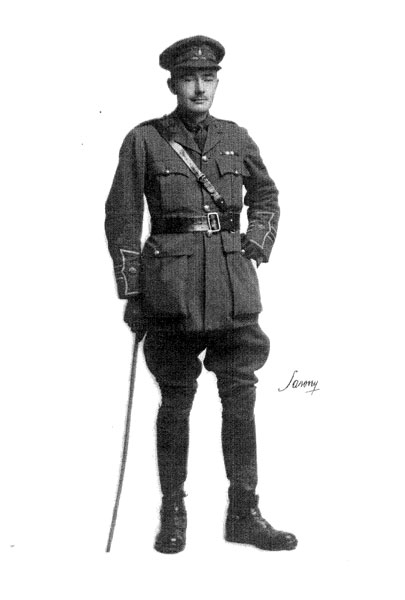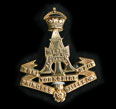
Major Harold Brown, DSO MC
Kaspar Stuart (<kaspar_stuart@hotmail.com>), - great grandson of Major Harold Brown, supplied the above photo and the following information on his great-grandfather (written in September 2010).
"Major Harold Brown was a friend of Lt.Col Sir Mark Sykes and had founded a school for disabled young men before the war. His father, George Brown also gave a house, called the Hollies and its gardens to Leeds City Council in memory of Harold Brown, which is now an old peoples home. His daughter-in-law (may grandmother) is still with us and will be 100 in November. She now lives with me in Paris. The last of Harold Brown's four children to still be living, who vividly remembered their father and those times was his daughter Elizabeth who died in America in 2000. "
The information below was gathered by the Beck isle Museum in Pickering as part of its Great War Project;-
Acting Major Harold Brown was born in Bournemouth on 4th January 1879 into a fairly wealthy middle class family, but as he grew up decided to head north (via Cambridge University) and eventually ended up with his wife Dorothy in Filey, where they lived at Linkfield, 61 West Ave. Unfortunately, very little of his civilian and social life is known but an excellent record of his life in the military has been recovered by Rodger Dowson, to whom I am very grateful for allowing me to view his research and efforts.
Harold Brown was educated at Loretto School, Edinburgh, between 1895 - 1899.
(Ref.
Loretto School Roll of Honour).
He is commmeorated on the Loretto
School War Memorial in the School Chapel.
Brown, in his civilian career was a Schoolmaster, although not at Filey School,
so presumably a private one which would probably in keeping with his University
career, as he achieved a BA from Jesus College, Cambridge where he studied
between 1898 and 1902. It was here that he first received his first taste
of military life, when he joined the 4th Battalion Royal Suffolk Regt., otherwise
known as the Cambridge University Rifle Volunteers as a Territorial. Below
are his service details for this time, including his length of time at each
rank:
Private H. Brown
Enlisted: 11-10-1898 to 20-3-1900
Length at rank:1 year 160 days
2nd Lt. H. Brown
Gazetted: 21-3-1900 to 12-6-1900
Length at rank:0 years 84 days
Lt. H. Brown
Gazetted: 13-6-1900 to 27-11-1900
Length at rank:0 years168 days
Captain H. Brown
Gazetted: 28-11-1900 to 5-12-1902
Length at rank: 2 years 8 days
TOTAL TIME SERVING IN REGIMENT: 4 years 55 days
At this point, Harold had finished his degree and therefore left Cambridge,
so resigned his commission and unfortunately from this point nothing is known
until 1914, when he is living in Filey at Linkfield, 61 West Ave. with his
wife and was working as a teacher. However, he re-enlisted on 14th June 1914
as part of the Territorial Force and was made a Lieutenant on the 18th in
the 5th Battalion, (Princess of Wales Own) Yorkshire Regt., which was to become
his ‘home’ until 1917.
The next known mention of Lt. Brown is in Mark Marsay’s book "Baptism
of Fire" which chronicles the history of the 5th Battalion during the
Great War when the Battle of St. Julien (near Ypres) is discussed. On the
25th April 1915, ‘D’ Company under the command of a Captain Geoffrey
Barber, with Lt. Brown as second in command and Lance-Corporal Claude Dell
as the NCO, were ordered to take a farmhouse that contained a machine gun
nest and hold the position from the enemy, a task which was virtually impossible.
The position was never taken and ‘D’ Company suffered nine casualties
out of a strength of 25, including Captain Barber and Lance-Corporal Dell
and it was up to Lt. Brown to lead the remaining party back to the lines,
very demoralised. However, it is recorded that after nightfall Brown went
out into no-mans land by himself and recovered the body of L/Cpl. Dell and
buried him, an act which apparently earned him a great deal of respect from
the soldiers serving under him. After this, nothing is known of his actions
until he was awarded the Distinguished Service Order on the 24th July 1915
for an act that is unfortunately still a mystery but probably earned him the
rank of Captain, as he is recorded as this at this point.
This good fortune was not to last though, as on the 6th August he was taken
ill with appendicitis and was forced to leave his unit, now the 1st/5th Battalion,
and he sailed for Dover from Dieppe on Friday the 13th August aboard the hospital
ship ‘Anglia’. At a medical board review in September the following
was recorded:
"On the 6th August at Armentieres he was suddenly attacked wit the symptoms
of appendicitis and was in severe pain…He was sent home and the first
operation was performed on 19th August. He appears to be recovering well."
He was pronounced fit for active service again on 4th November 1915 and between
that point and the 16th September 1916 remained in France. He led the charge
in the Battalion’s celebrated victory of the crater raid at Petit Bois
in May 1916 and was awarded the Military Cross on the 25th August 1916 (although
it is unsure whether this is for his action during the raid). However, on
the 16th September he was wounded and ended up in a field hospital until the
25th, when he sailed again for Dover, this time from Calais aboard the S.S.
Brighton . The medical case sheet with him stated:
"The explosion of a shell in his immediate vicinity rendered him unconscious
for a short time. When he came to he found he had a gunshot wound to the dorsum(?)
of his right foot and also damage to is ear."
It was the 23rd of November before he was declared fit for service and he
returned once again to duty, although at the medical board a note was made
that the hearing in his right ear was severely impaired but not permanently
damaged and also that the movement in his right foot would be slightly impaired,
again though not permanently. After returning he was awarded the Croix de
Guerre on the 9th December and was later mentioned in dispatches on the 29th
of the same month, although again these actions are not known. He was posted
to the 4th (Reserve) Battalion, Yorkshire Regt. after his injury who were
training at Scotton Camp, Catterick but was sent home again only a couple
of months after the Battalion reached the front with a further gunshot wound
and head wound. This time though, the injuries were serious and Brown spent
a month in No. 8 Field Hospital (Rouen Base-No.366/17) as he was too sick
to be moved. An addition to his case sheet was made that said:
"Patient was admitted on the 28th April 1917 having acquired his wounds
two days previously [presumably, this time was spent either in no-mans land
or an advanced dressing station] The wound of the thigh is an open shot wound
and is improving favourably but following the blow to the head he has complained
of excruciating headaches since his first admission"
When the medical board declared him stable enough to return to England (on
the 10th May) they also added this:
"Wounded at the place and date by a rifle bullet which penetrated the
anterior surface at the thigh, about six inches above the knee causing a flesh
wound. Abscesses also now present as wound has not healed…he received
a contusion to the left side of the head at the same time as he received the
other wound. The only effect he now feels is a slight numbness in the fore
and middle finger of the right hand."
He was returned to Southampton on the S.S. Normania from Le Havre and was
sent to Furness Auxiliary Hospital, Harrogate where he recovered until he
was declared fit for active service on 24th July and was told to sail from
Folkestone on the 15th August. At this point Brown had received a promotion
to the rank of Captain and Brevet Major and when he reported 3rd Echelon,
Boulogne base found he had been posted back to his original battalion, the
5th. Between this point and the 30th December 1917 he was with his old battalion
but he was gazetted on this date to the rank of Acting Major and placed as
second in command of the 4th Battalion, Yorkshire Regt. where he spent his
remaining days.
On the 23rd March 1918 whilst acting as Commanding Officer for the 4th Battalion
Acting Major Harold Brown was killed in action at the action of Brie on the
Somme, on the third day of the 1918 German Spring offensive at the age of
39. He is remembered on the Pozieres memorial, as his body was never found
and also on the Green Howards, Sledmere memorial where a bronze statue of
him has been placed.
-----------------> Return to top of the page
